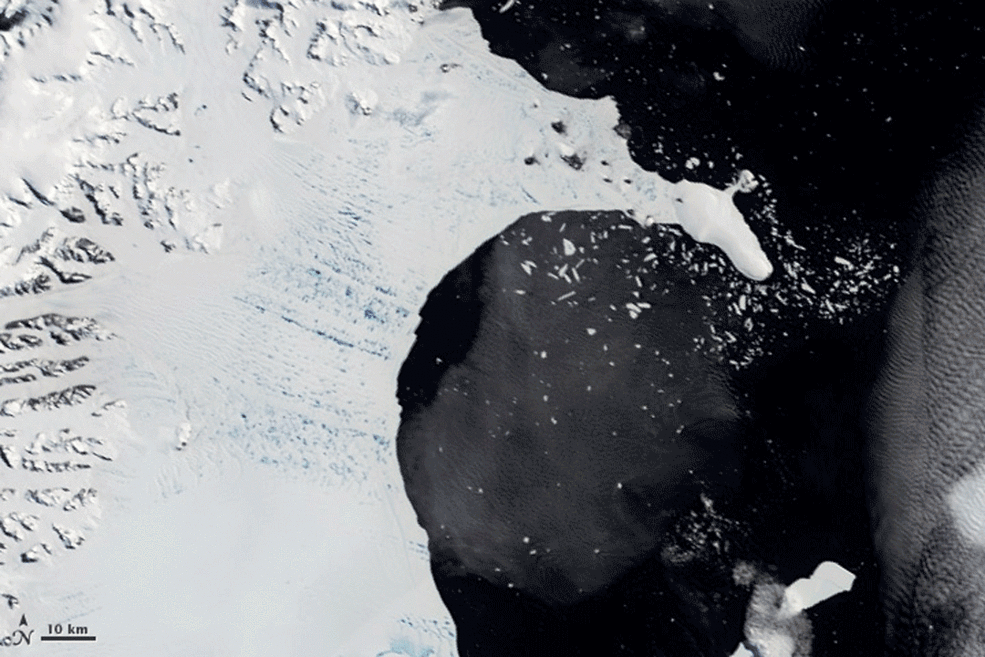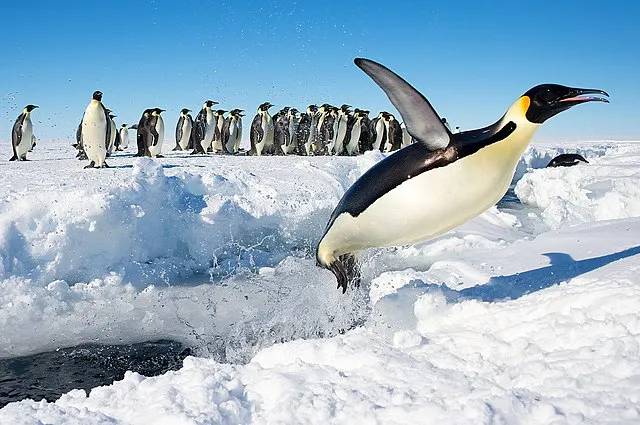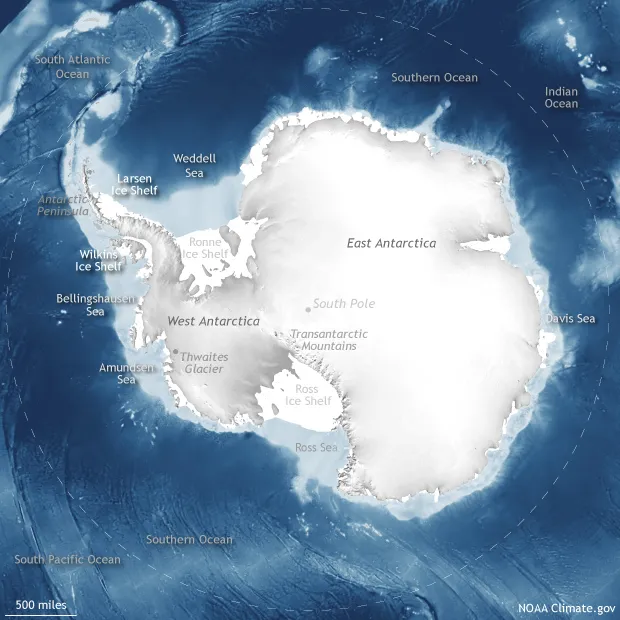Warming in Antarctica
While the Arctic has consistently warmed as global climate changes, the impacts in the Antarctic are more complex.
Temperature on the Antarctic Peninsula
The Antarctic Peninsula, the part of Antarctica furthest from the South Pole, has been warming rapidly, five times faster than the global average. Since 1950, the Antarctic Peninsula has warmed almost 3°C (5.4°F). That's more warming than anywhere else in the Southern Hemisphere. Overall warmer temperatures along the peninsula are increasing ice melt and have caused several ice shelves to break apart.
Collapsing Ice Shelves
Between 1992 and 2017, Antarctica lost more than three trillion tons of ice, most of which came from the West Antarctica Ice Sheet. Some of the most dramatic impacts of warming are collapsing ice shelves in West Antarctica, which are caused by warming. The animation at the left shows the historic breakup of the Larsen B Ice Shelf. Ice shelves are like bookends that support ice sheets and glaciers, helping them stay on land. When an ice shelf collapses into the ocean, the glaciers that it held in place begin to slide into the sea at an accelerated rate.
Parts of the Antarctic ice shelves float in place over the ocean, and the breakup of these ocean-based ice shelves does not directly contribute to sea level rise. However, the ice shelf collapse can contribute to sea level rise indirectly, as the glaciers feeding into the ice shelf speed up and flow more quickly out to sea. Scientists are finding that Antarctic glaciers move faster towards the Southern Ocean once an ice shelf is gone.

Collapse of the Larsen B Ice Shelf in Antarctica between Jan 31 and April 13, 2002.
NASA Earth Observatory
Since the late 1980s, a number of Antarctic ice shelves have collapsed or retreated. While the West Antarctic Ice Sheet suffered some of the largest early losses, the East Antarctic Ice Sheet is being affected as well. In late March 2022, the 1,191 square mile Conger Ice Shelf (about the size of Los Angeles) collapsed, shortly after a surge of warm air resulted in temperatures that were a record 40°C (72°F) above normal.
Demise and collapse of Conger ice shelf from Stef Lhermitte on Vimeo.
In total, parts of 21 ice shelves on the Antarctica Peninsula broke apart between 2000 and 2020. At sustained warming levels between 2°C and 3°C, the West Antarctic Ice Sheet will be lost almost completely and irreversibly over thousands of years.
Warming of the Southern Ocean
The water in the Southern Ocean is also warming. Warmer ocean water not only speeds the melting of ice shelves, but also has an impact on the sensitive marine ecosystem of the Southern Ocean. Antarctic krill, an important animal the start of the Southern Ocean food chain, are projected to lose up to 80 percent of their habitat by 2100 because of warming waters and melting sea ice.
Loss of Penguin Habitat
Areas of the Antarctic Peninsula that were once lively Adélie penguin colonies are now abandoned because of less winter sea ice. The remains of their simple rock nests litter the landscape. Many of these penguins have moved south to colder areas. Scientists are concerned that gentoo penguins, who live in isolated colonies and do not typically swim far from home, might not be able to relocate as easily as other penguin species as climate change makes their current habitat unsuitable.
Emperor penguins are also affected because the sea ice they depend upon for breeding is melting. The numbers of Emperor penguins are already declining as a result of climate change. Scientists predict that if greenhouse gas emissions continue to rise at levels similar to today—causing temperatures to rise and Antarctic Sea ice to shrink—the penguin population numbers will diminish slowly until about 2040, after which they would decline at a much steeper rate as sea ice coverage drops below a usable threshold. Nearly 98% of Emperor penguin colonies are at risk of disappearing by 2100.

Antarctica's Emperor penguins are at risk and could be faced with extinction as sea ice is lost.
Creative Commons Christopher Michel
Predicting Change to the Antarctic Continent
Unlike the rapidly warming Antarctic Peninsula, patterns of temperature change in the interior of the Antarctic continent are less certain. Scientists use advanced models, such as the Community Earth Systems Model (CESM), as well as observational studies, to advance our understanding of Antarctic systems. The massive East Antarctic Ice Sheet, which is about 3 miles (5 kilometers) thick at its highest point, was previously thought to be too large to be affected by changes in climate, however recent studies show that the ice sheet does, in fact, seem to respond to shifts in temperature. Scientists predict that continuing to put greenhouse gases in the atmosphere will speed up in changes in East Antarctica that are similar to what is happening in the Arctic and West Antarctica, and warn that melting Antarctic ice could cause rapid sea level rise.

Ice shelves in West Antarctica and along the Antarctic Peninsula, such as the Larson B Ice Shelf and the Wilkins Ice Shelf, are collapsing due to climate warming. As floating ice shelves along the edges of the continental ice sheet collapse, the ice sheet on the continent becomes unstable.
NOAA